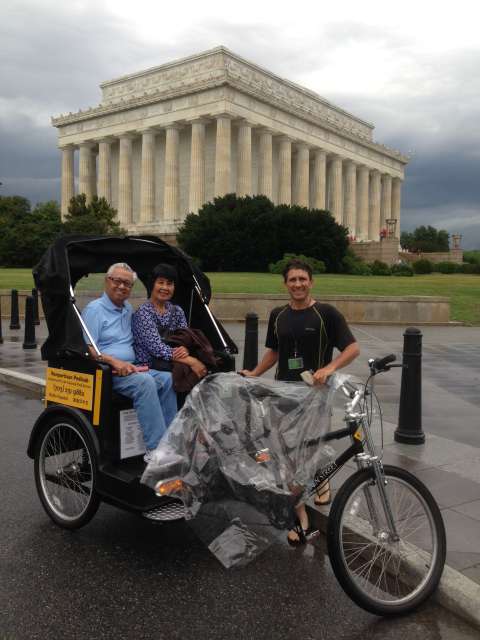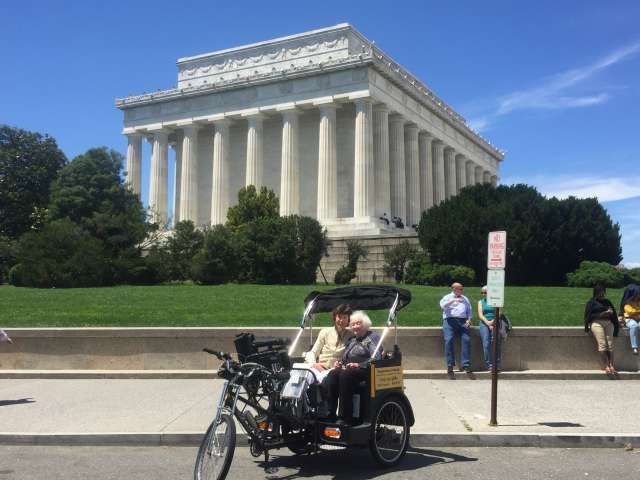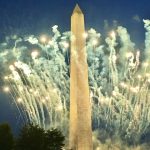Things to Do in DC – Visit the Lincoln Memorial
One of the Best Things to Do in DC is Visit the Lincoln Memorial
A visit to the Lincoln Memorial is an unforgettable experience, and at the top of the list for every visitor to Washington DC. The Lincoln Memorial commands a sweeping view of the entire National Mall. From the steps of the Lincoln Memorial, one can see the Reflecting Pool, the Washington Monument and all the way down to the US Capitol. One of the best things to do in DC is to go on a tour of the monuments, where you can go to each different monument in turn and get out and walk around.
Lincoln Memorial — Opening Hours and Fees
The Lincoln Memorial is always free to the visiting public. There is never any charge, even at busy public events such as July 4th. Furthermore, the Lincoln Memorial is open 24 hours a day, 7 days a week, 365 days a year.
Getting to the Lincoln Memorial
The nearest Metro stations are about a mile away. You have 4 to choose from, all about equally distant. The Foggy Bottom station is at 23rd and I Streets NW. The Smithsonian station is at 12th and Independence SW. Federal Triangle is on 12th St. NW off of Constitution Avenue. You can get the Orange/Blue/Silver lines at each of these stations. The Arlington Cemetery Station is across the Arlington Memorial Bridge on the Virginia side. Only the Blue line stops here. Be aware that this station closes at 10:00PM. There is a Capitol Bikeshare stand directly at the Lincoln Memorial. One of the best things to do in DC is to get around by pedicab. A pedicab tour will allow you to stop at all the monuments in about two hours.
Parking at the Lincoln Memorial
There is some metered on-street parking on Ohio Drive, and also some metered parking on Constitution Avenue.
On-street parking on the National Mall is no longer free of charge. Three hour parking is available at $2 per hour. Parking meters only accept credit cards.
Handicapped Facilities at the Lincoln Memorial
There is an elevator in the interior of the Memorial where you can go up into the inner chamber at the top of the steps. Nonpartisan Pedicab offers specialized Washington DC tours for handicapped and disabled visitors. In front of the Lincoln Memorial on Daniel French Drive is a National Park Service information kiosk. During their working hours, they will lend you a free wheelchair to tour the Lincoln Memorial, the Korean War Memorial, and the Vietnam Memorial. Metered handicapped parking is available on Daniel French Drive.
Looking for the Best Tours of Washington DC?
Looking to take in the monuments, museums, the White House and the US Capitol?
Food and Restroom Availability
There are restrooms immediately to the left of the stairs leading up the Memorial. There are two food kiosks — one on either side of the Memorial. Here, you can get hot dogs and soda and some other fast food. There are a few healthier options such as bananas, yoghurt and some wraps as well. The food kiosk on the north side of the Memorial also sells souvenirs.
Attractions Nearby to the Lincoln Memorial
There are three memorials in the vicinity. The Korean War Veterans Memorial, the Vietnam War Veterans Memorial, and the Einstein Memorial. One of the best things to do in DC is to take a pedicab tour of the monuments, which would allow you to stop at all these monuments and much more.
History and Facts about the Lincoln Memorial
Located at the West end of the national mall in Washington, DC, the Lincoln Memorial honors the 16th President of the United States, Abraham Lincoln. Begun in 1914, the building was designed by architect Henry Bacon. The interior includes a 19-foot seated statue of Lincoln by Sculptor Daniel Chester French, murals by painter Jules Guerin, and two well-known speeches by Lincoln. The memorial has been the site several famous speeches and gatherings, including Martin Luther King’s “I Have a Dream” speech, delivered on August 28, 1963, during the rally of the March on Washington. The memorial ranked seventh on the 2007 list of America’s Favorite Architecture by the American Institute of Architects.
Shortly after the death of Lincoln in 1867, Congress created the Lincoln Monument Association to build a memorial. Initially, a design was considered for a six equestrian and 31 pedestrian statues of colossal size, with a 12-foot statue of Lincoln in the center. The project was never started for lack of funds. Not until 1910 did two members of Congress, Shelby M. Cullom and Joseph G. Cannon, who had known Lincoln in Illinois, push through a Lincoln Memorial bill which President Taft signed in February 1911. The bill created a Lincoln Memorial Commission to oversee the project and allotted $2 million in funds. The final cost of the memorial, however, was $3 million.
The first stone was put into place on Lincoln’s birthday, February 12, 1914. On May 30, 1922, the monument was dedicated by Former President and Chief Justice William Howard Taft on May 30, 1922, 57 years after the death of Lincoln. An estimated 50,000 people attended the ceremonies, including hundreds of Civil War veterans and Robert Todd Lincoln, the only surviving son of the president.
New York architect Henry Bacon modeled the memorial in the style of a Greek Doric temple. The classical building measures 204 feet long, 134 feet wide, and 99 feet tall, with 44-foot columns– design features 36 columns outside symbolizing the states in the Union at Lincoln’s death (the 25 U.S. states as well as the 11 seceded States). The structure synthesizes white Colorado marble for the exterior, Indiana limestone for the interior walls, pink Tennessee marble for the floor, and Alabama marble for the ceiling. The names of all 48 states in the Union at the time of the completion of the memorial in 1922 are carved in the exterior attic walls. Following the admission of Alaska and Hawaii, a memorial plaque in the plaza to commemorates their admission in 1959. In 1923, Bacon received the Gold Medal of the American Institute of Architects for the design of the memorial.
The interior statue of Lincoln, at the center of the building between chambers, was designed by Daniel Chester French and carved by the Piccirilli Brothers of New York. Made of 28 separate blocks of white Georgia marble and weighing 175 tons, it measures 19 feet tall and 19 feet wide. Beneath the hands Lincoln, the Roman fasces, symbols of the authority of the Republic, are sculpted in relief on the seat. The memorial plans originally specified a 12-foot bronze statue, but such a design proved out of scale for the huge building. On the north and south walls two side chambers of the memorial are inscriptions of Lincoln’s Gettysburg Address and his Second Inaugural. Above them, Jules Guerin painted murals represent the principles of freedom, justice, unity, brotherhood, and charity.
In 1939, the Roosevelt administration arranged for contralto Marian Anderson to perform from the steps of the Lincoln Memorial on Easter Sunday of that year, to a live audience of 70,000, in a concert that played on national radio. On August 28, 1963, the memorial was a rally site for the March on Washington for Jobs and Freedom, a significant event in the American Civil Rights movement. An estimated 250,000 people came to the memorial where Martin Luther King, Jr., deliver his memorable speech, “I Have a Dream,” A tile on the memorial’s steps marks where Dr. King stood.
Further information can be found at the National Park Service Lincoln Memorial page. Or at the Wikipedia Lincoln Memorial page.









